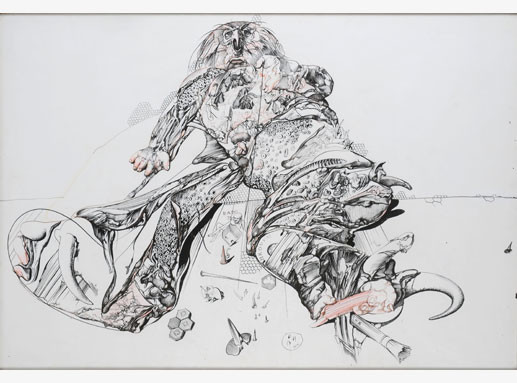Dado
21 Apr - 24 Jun 2012

Dado
Frida, 1973
Photo: Losi
Courtesy Galerie Jaeger Bucher/ Jeanne Bucher, Paris
© VG Bild-Kunst, Bonn 2012
Frida, 1973
Photo: Losi
Courtesy Galerie Jaeger Bucher/ Jeanne Bucher, Paris
© VG Bild-Kunst, Bonn 2012
DADO
Danse Macabre
21 April – 24 June 2012
Dado (Miodrag Djuric, 1933-2010) was born in Montenegro and went to Paris in 1956. He found support there for his work as an artist from Jean Dubuffet, Bernard Réquichot and Horst Kalinowski and was mentored by the art dealer Daniel Cordier, whose gallery was the
site of his first solo exhibition in 1958. From 1960 he lived and worked in an old mill in Normandy, where his produced paintings, drawings and prints – surrealistic images, brutal and existential depictions of a fantastic horror. Dado, who was friends with Hans Bellmer and Unica Zürn since 1962, described himself as a “philosopher of everything twisted.” His obsessive, often nightmarish pictures
have close ties to and are rooted in Surrealism. They have a deep melancholy that is inherent to all living creatures and are simultaneously expressions of uncompromising humanity. Dado’s pictures depicting the bustle of human misery are inhabited by numerous boisterous and grotesque monsters and peculiar creatures. The people are degenerated, swollen and misshapen, bloated and hacked to pieces. The fleshy structure has been dissolved; the ink strokes suggest a transparency, in the opaque absurdity of which horrors have established themselves and appear malleable at the same time. The forms melt, often characterising a catastrophic state of emotional dismemberment and horrifying physical decay. At a time dominated by Abstract Expressionism, Dado became an important model for such exponents of a new figuration in art as Eugen Schönebeck and Georg Baselitz. The Kunsthalle is exhibiting a selection of his early drawings dating from the 1960s.
Danse Macabre
21 April – 24 June 2012
Dado (Miodrag Djuric, 1933-2010) was born in Montenegro and went to Paris in 1956. He found support there for his work as an artist from Jean Dubuffet, Bernard Réquichot and Horst Kalinowski and was mentored by the art dealer Daniel Cordier, whose gallery was the
site of his first solo exhibition in 1958. From 1960 he lived and worked in an old mill in Normandy, where his produced paintings, drawings and prints – surrealistic images, brutal and existential depictions of a fantastic horror. Dado, who was friends with Hans Bellmer and Unica Zürn since 1962, described himself as a “philosopher of everything twisted.” His obsessive, often nightmarish pictures
have close ties to and are rooted in Surrealism. They have a deep melancholy that is inherent to all living creatures and are simultaneously expressions of uncompromising humanity. Dado’s pictures depicting the bustle of human misery are inhabited by numerous boisterous and grotesque monsters and peculiar creatures. The people are degenerated, swollen and misshapen, bloated and hacked to pieces. The fleshy structure has been dissolved; the ink strokes suggest a transparency, in the opaque absurdity of which horrors have established themselves and appear malleable at the same time. The forms melt, often characterising a catastrophic state of emotional dismemberment and horrifying physical decay. At a time dominated by Abstract Expressionism, Dado became an important model for such exponents of a new figuration in art as Eugen Schönebeck and Georg Baselitz. The Kunsthalle is exhibiting a selection of his early drawings dating from the 1960s.
